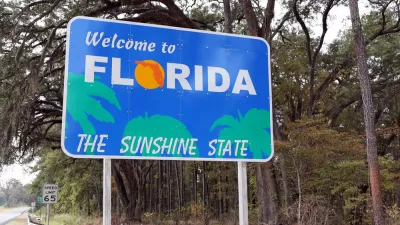The New York Times recently visualized domestic migration and population makeup for each state in the United States from 1900 until today using Census data.
For every state in the United States, population was divided by resident's state of birth. Foreign-born residents are also included to gain a better understanding of population makeup and migration within the United States. Here are some of the highlights of the 50 state feature:
While the least diverse state is Louisiana, with about 79 percent of today's residents born in-state, Colorado, the most diverse state, boasts only 42 percent of residents born in-state.
North Dakota's recent natural gas boom explained by the, "transplant population from 15 states increas[ing] by at least 1,000, while the North Dakota native population has actually shrunk."
Michigan illustrates how deindustrialization affects domestic migration. "Michigan used to have a significant population of people born in other Midwestern states and in places like Pennsylvania, Kentucky and North Carolina. With fewer high-paying factory jobs, fewer transplants have moved in from these states."
Considered one of the fastest-growing states on the East Coast, "As recently as 1980, 76 percent of [North Carolina] residents were natives, and the next-largest source of state residents was South Carolina. Today, there are twice as many North Carolina residents born in New York as were born in South Carolina."
California, once a dream land for Americans throughout the country, "today, the state is still pulling in foreign immigrants, but the percentage of American-born transplants has shrunk significantly as more people leave the state. There are now about 6.8 million California natives living elsewhere, up from 2.7 million in 1980."
FULL STORY: Where We Came From, State by State

Maui's Vacation Rental Debate Turns Ugly
Verbal attacks, misinformation campaigns and fistfights plague a high-stakes debate to convert thousands of vacation rentals into long-term housing.

Planetizen Federal Action Tracker
A weekly monitor of how Trump’s orders and actions are impacting planners and planning in America.

In Urban Planning, AI Prompting Could be the New Design Thinking
Creativity has long been key to great urban design. What if we see AI as our new creative partner?

King County Supportive Housing Program Offers Hope for Unhoused Residents
The county is taking a ‘Housing First’ approach that prioritizes getting people into housing, then offering wraparound supportive services.

Researchers Use AI to Get Clearer Picture of US Housing
Analysts are using artificial intelligence to supercharge their research by allowing them to comb through data faster. Though these AI tools can be error prone, they save time and housing researchers are optimistic about the future.

Making Shared Micromobility More Inclusive
Cities and shared mobility system operators can do more to include people with disabilities in planning and operations, per a new report.
Urban Design for Planners 1: Software Tools
This six-course series explores essential urban design concepts using open source software and equips planners with the tools they need to participate fully in the urban design process.
Planning for Universal Design
Learn the tools for implementing Universal Design in planning regulations.
planning NEXT
Appalachian Highlands Housing Partners
Mpact (founded as Rail~Volution)
City of Camden Redevelopment Agency
City of Astoria
City of Portland
City of Laramie





























